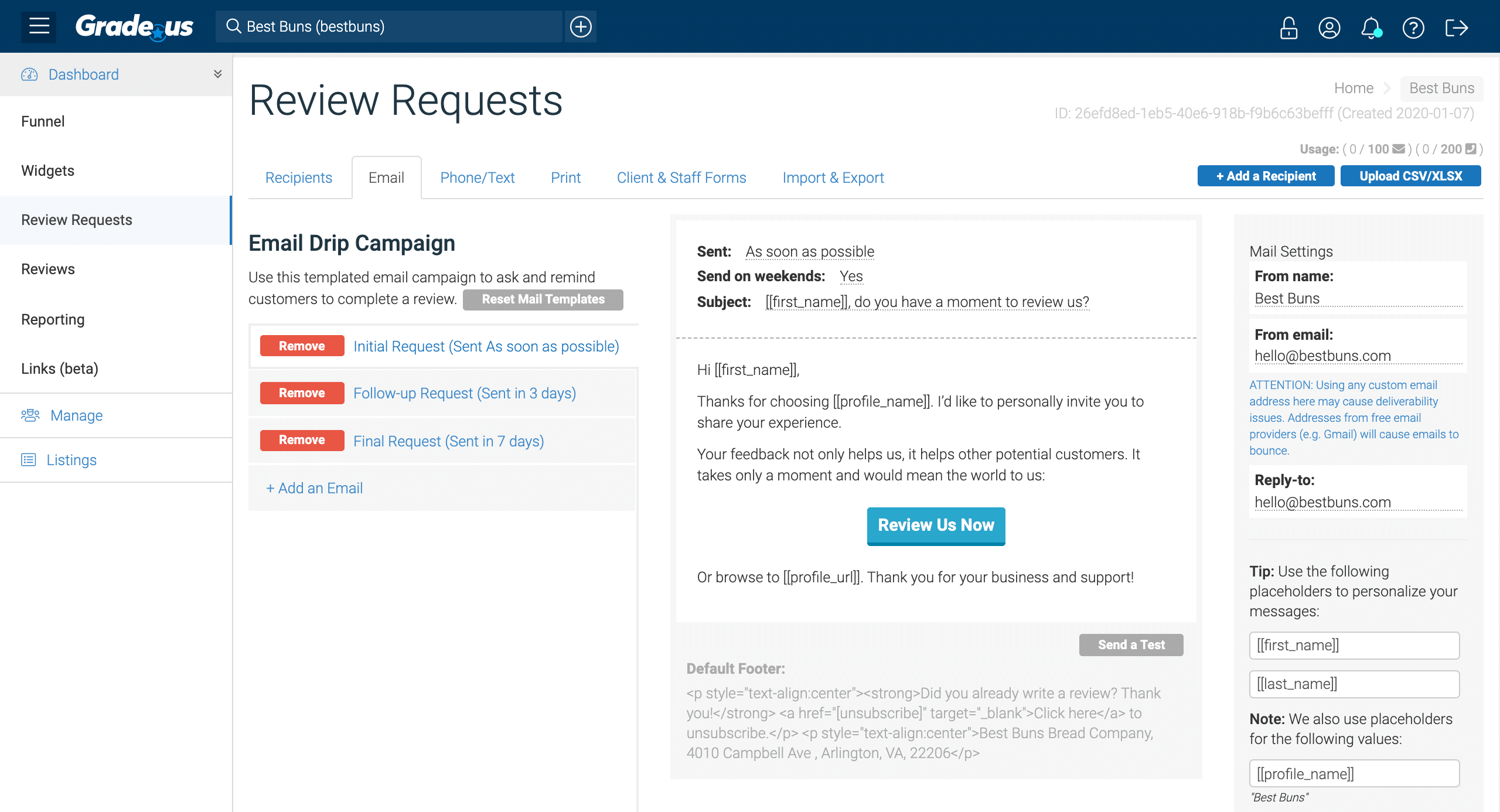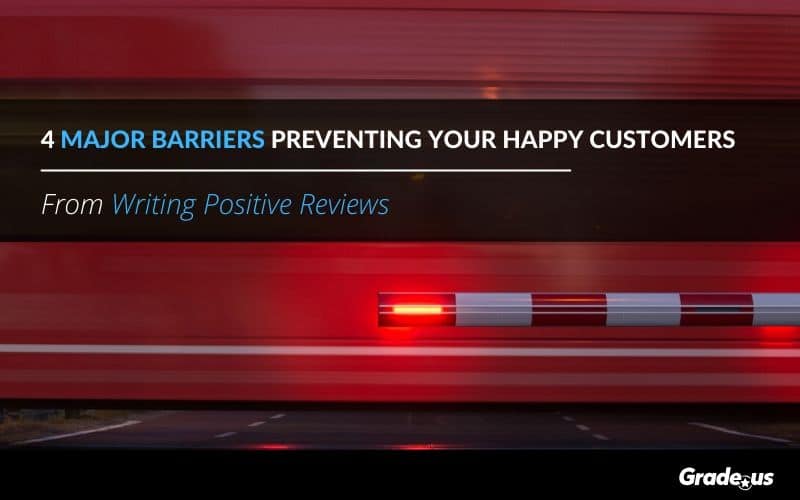Updated: 3/2/2020
You want your customers writing positive reviews, you’ve exceeded your customer’s expectations. You’ve under-promised and over-delivered. Maybe you’ve taken a loss for them. Or you’ve pulled a series of all-nighters.
You’ve gone above and beyond.
When you talk to them, they’re full of praise. So why won’t they do it? Why won’t they write a review (positive or negative) for your business?
Barriers.
Barriers that keep customers from writing positive reviews
Happy customers are typically open to the idea of writing a review. Unhappy customers, on the other hand, are more motivated to write a negative review.
But both customers are in the minority.
The vast majority of customers don’t leave reviews. They don’t offer feedback. There’s a wide variety of reasons, but it really comes down to a few common barriers.
Aside from expectations, these barriers determine whether you’ll be able to get a customer to write a review.
So, how do you get more customers to write reviews?
It’s simple.
You eliminate the barriers.
But first, you have to identify them.
Barrier #1: Happy customers are secretly unhappy
Most customers aren’t open with the companies they do business with. The sad part? Many happy customers are secretly unhappy. Contrary to popular belief, many of these customers are unwilling to share the reasons behind their unhappiness.
Most customers won’t bother to tell you they’re unhappy.
Skeptical?
Let’s look at a few stats, mined by Help Scout.
- For every customer who bothers to complain, 26 other customers remain silent. Source: White House Office of Consumer Affairs
- A typical business hears from 4% of its dissatisfied customers. Source: “Understanding Customers” by Ruby Newell-Legner
- Resolve a complaint in the customer’s favor, and they’ll do business with you again 70% of the time. Source: Lee Resources
- 91% of unhappy customers will not willingly do business with you again. Source: Lee Resources
Here’s the real reason customers won’t tell us the truth. We’re socialized to be “nice.” Telling the truth often comes with unpleasant consequences.
And when it doesn’t?
Delivering bad news or constructive criticism feels yucky, especially when customers feel it’s petty, tiny or insignificant. Delivering good news can create headaches, especially when the recipient of said news takes it pretty hard or reacts negatively.
For some customers, it’s just not worth it.
These customers feel it’s better to keep their thoughts, feedback and opinions to themselves simply.
So, how do you fix this?
Create an environment of safety. On the surface, that sounds easy but it can be difficult to apply. Here are a few strategies you can test in your business.
1. Welcome horrible reviews. When customers write a negative review, it’s a wonderful opportunity. It’s a chance for you to show prospective customers you’re a safe company to do business with. When something goes wrong, customers know you’ll take good care of them. Thank customers for their unpleasant review, act on their feedback, then show what you’ve done.
2. Ask customers for good, bad, and ugly feedback. Reassure customers, letting them know it’s safe for them to hold you and your staff accountable. Then, keep your word. New customers will test you; they’ll attempt to verify your words. Handle it well and you’ve earned their trust (and a review). Mess things up and they’ll quietly slip away.
3. Improve staff EQ. Give staff the incentives they need to eliminate dysfunctional behavior. Use training, resources, and tools to eliminate the big four relationship killers – condescension, contempt, defensiveness and stonewalling. Be kind, be helpful or your chance at a review will be gone.
4. Promote clarity over persuasion. Anticipate and defuse concerns, objections, risks, and fears ahead of time. Create policies that ensure customers feel safe and treated well.
Customers write positive reviews for two reasons:
1. Altruism. These customers are looking out for other prospective customers. If they’re happy, these customers spread the good news organically. Here’s the great part about working with these customers. If you align your business with their altruism, they’ll be more than willing to share positive reviews on your behalf. Here’s the bad news. If there’s a hint or whiff of what they perceive as selfishness, you’ve lost them.
2. Helping your company. These customers want to reciprocate; they want to write positive reviews for your company. If they’ve had an exceptional experience with your business, one that exceeded their expectations, they’re far more likely to do so. The “helping your company” category is a broad one. This category includes customers you’ve gone above and beyond for, those jumping on the positive reviews bandwagon and customer loyalists who are willing to jump through hoops for you.
Your customers are willing to write a positive online review if you’re willing to ask for it. That’s the problem here; 67% of consumers have been asked for reviews. It’s certainly an improvement over previous years, but it’s still not where it should be.
Here’s why that matters.
76% of consumers leave reviews when asked, up from 70% in 2018. Consumers understand the value of a positive review, and they’re willing to write them.
Barrier #2: Customers don’t remember what you did
This is why they can’t write a review on your behalf. Do a great job and customers are far more likely to forget. Do a bad job and customers never forget.
It’s not fair but it is consistent.
As it turns out, there’s an explanation for this. An experiment tested memory and approach‐avoidance ratings for television news images that induce anger, fear, and disgust. Here’s what researchers found.
“Images that induce anger were found to be the most memorable on a latency‐to‐response measure, followed by images that induce fear, and images that induce disgust.”
This is confirmed in several other studies. Negative information is, unfortunately, more memorable. This happens because of our negative bias.
We all have one.
As people, we’re on an obsessive hunt for problems. For disasters, fears, and frustrations. Research shows we’re far more attuned to the negative events in our lives than we are to the positive.
Our negative bias keeps us safe.
It’s an important survival mechanism we depend on from the time we’re born.
- Problems create stress and anxiety
- Solutions (you) relieve stress and anxiety
When you give customers the solution they so desperately need, you give them relief. That’s a good thing (obviously) but it’s also a bad thing.
Because relief induces forgetfulness.
The longer you wait to ask customers for their feedback (or a review), the less likely they are to remember what you actually did for them.
So, how do you fix this?
It’s simple.
You ask customers for their feedback or a review, immediately or shortly after they’ve purchased and used your product. Here’s why this is so important. If your customers forget what you’ve done for them, they won’t tell you. In fact, the better your performance, the more ashamed they’ll feel about forgetting all that you’ve done for them.
Kind of obvious, right?
These feelings of shame motivate your customers to hide. Most don’t want to admit that they forgot what you did for them. There’s actually a better way. You prime the pump. When you sign customers up, you tell them you’re going to do a regular check-in to make sure they’re taken care of, like this:
Hi [Customer Name]!
So excited you’ve decided to join our tribe! We’re excited to have you as a customer.
So here’s the thing.
I want to make sure you’re taken care of. So, we want to reach out to you once a week with a quick 2 min chat to make sure you’re being taken care of.
Would that be okay?
You can use these check-ins to share feedback, concerns, complaints, vent about a problem – it’s all fair game!
You’re amazing!
[Your Signature]
P.S. Prefer to skip these check-ins? No problem! Just let us know.
You’ll obviously want to customize things for your business, but you catch my drift, right? Then, you save each “check-in” with your customer. If you can, it’s also a great idea to use an automated review management tool like Grade.us to generate review requests.

Review conversion rates go way up when the email “ask” is combined with a face to face request.
Save live chats, record phone calls (get permission), save emails.
You dramatically reduce churn and you gain valuable insights to make them happy. And the best part? Customer reviews are baked right in!
What about your customer’s negative bias?
Wouldn’t this be a major problem if you’re trying to get customers to write positive reviews on your behalf? Not really, no. In fact, your customer’s negative bias can be a powerful tool in the right hands. This negative bias can amplify the effectiveness of your customer reviews, boosting results in the long term.
How can you use that to encourage customers to write positive reviews?
By uncovering your customer’s:
- Inexperience can manifest itself as fear, risk, objections, insecurity, or a general lack of knowledge.
- Past experiences - were customers mistreated, did they have a bad experience with a particular provider or product?
- Customer perceptions are shaped by expectations - the fuzzy, implicit, and unrealistic expectations. These expectations must be sculpted and shaped by your brand rather than customers.
Here’s how you do it.
You ask customers questions about each of the above items. You create a series of questions (see Barrier #4) that uncover these ideals naturally. When you ask the right questions, you end up with high-performance reviews that have the following ingredients:
- Desires: Your customer's secret wants and needs, the big picture details that keep them up at night.
- Goals: You're able to identify what customers want and why they're writing a review.
- Fears: These fears appear as barriers, risks, objections, etc.
- Frustrations: The problems that prevented them from achieving the goals or outcomes they wanted.
- Outcomes: The solutions you provided customers, their outstanding experience or the incredible results you were able to achieve on their behalf. It's the realization of their desires and goals.
These are the kind of reviews that attract, win, and retain wonderful customers.
Barrier #3: It’s too hard to write or share a review
Great success! You have a customer who’s able and willing to share a positive review. They decide to search for your business on Yelp, and they can’t seem to find the right profile.
They spent 15 min writing a review only to lose it.
It’s too time consuming. Or too whatever.
Customers write reviews for a wide variety of reasons. Customers stop caring when it becomes tough to actually write a review – whether that’s on your site or a third party site.
You know what that means. They lose interest, and they abandon their review. And just like that, the opportunity is gone.
Here’s the thing. It’s not just about technical difficulties, it’s also about direction. Customers don’t always know where to write or share their reviews. They need direction from you.
So, how do you fix this?
You make things ridiculously simple. You make it incredibly easy for them to write a review. Then you show them where you’d like their reviews to go, like this:
Hi [Customer Name]!
Your feedback was amazing! Thanks so much for sharing.
Would you be willing to share your feedback and advice with other customers if it only took 30 seconds?
Please let me know,
[Your Signature]
It’s ridiculously easy for customers to respond. All they have to do is write a “Yes” or “No.”
Okay. They’ve said yes. What do you do?
Thanks so much [Customer Name]!
Here’s what you’d have to do.
- Copy and paste your review below.
- Click this link
- Paste your review, select a rating and click Done
…..
[Customer’s review transcript goes here]
…..
Thanks again!
[Your Signature]
Grade.us automates this process with the review first layout. Try it for yourself below:
Alright… What if they say, “No?”
Hi [Customer Name],
No problem! Thanks for letting me know. I’m curious, what is it about sharing feedback that isn’t working for you?
Thanks for everything,
[Your Signature]
You’ll have some customers who ignore you anyway. That’s fine. Focus on the customers who answer. Thank them for their feedback, act on it (if possible), then show them that you’ve taken their advice. If you’re looking for a way to increase customer feedback here are some ingredients you need.
- Autoresponder messages (to send out review requests) via email and text
- Follow-up tools to reach out to non-responders
- A review funnel that directs customers to the review platform of your choice
- Promotion tools that allow you to market your four and five-star reviews effectively
You could do this manually, but it’s not scalable.
What if you don’t want to do the personal follow up? What if you’re looking for a systematic way to attract customer reviews? If you’re looking for a scalable way to attract reviews, you’ll need a review funnel. Semi-automation is key if you’re looking to gain traction quickly.
Creating a review funnel gives you the ability to scale quickly, reminding customers to write a review and share their feedback.
Barrier #4: Customers don’t know what to say
The biggest hidden barrier by far is awareness. Many customers simply don’t know what to say. So, rather than struggling with it, they do nothing.
You can change that.
You can guide customers. Does this mean you’re telling customers what to say and when to say it?
Absolutely not.
It means you’re focused on asking the right questions. Why do questions matter? And, how on earth will questions get you the amazing reviews you’re looking for?
Clayton Christensen, a professor at Harvard Business School, shared the answer.
“Questions are places in your mind where answers fit. If you haven’t asked the question, the answer has nowhere to go. It hits your mind and bounces right off. You have to ask the question – you have to want to know – in order to open up the space for the answer to fit.”
Customers can’t teach you about their experience until you’re ready to learn.
Ask the right questions, and you give customers the fuel they need to create amazing reviews — because reviews flow from feedback.
Ask customers the right question and the barrier – I don’t know what to say – fades away.
Which questions do you ask, and when?
First, start with the basics.
1. What would have prevented you from buying?
2. What did you find as a result of buying this?
3. What did you like most about our product (or service)?
4. What would be three other benefits to this product (or service)?
5. Would you recommend this to someone else? Why?
You can add additional questions as needed, provided that you make it easy for your customers.
Make it easy, and barriers come tumbling down.
Aren’t barriers unnecessary?
Believe it or not, barriers are necessary. Sounds crazy doesn’t it? Who makes it harder for customers to write positive reviews?
You do if you’re a savvy marketer.
Reviews are like magnets. Customers are drawn to them. That’s a problem if you have the wrong customers.
- Have discount shoppers? Offer great service, and you’ll attract more of their penny-pinching friends.
- Provide lots of "handholding?" You’ll attract more of the same demanding customers.
- Nightmare customer writes you a positive review? You’ll attract more customer predators looking to take advantage of your generosity.
What if removing barriers doesn’t get customers to write a positive review?
It won’t work for everyone.
But you’re not looking for everyone. You’re looking for all-stars, customer evangelists who’ll tell everyone they know about your business.
The diamonds in the rough.
Your customers are eager and willing to write a positive review
You’ve exceeded their expectations, you’ve under-promised and over-delivered. You’ve taken a loss for them. You’ve gone above and beyond. But when it comes to writing a review for you, they’ll still continue to struggle with following through.
Your customers need guidance.
When you discuss things with them, they’ll be full of praise. When you ask for feedback, they’ll do their best to be nice. But these barriers will keep them from writing a review.
Happy customers want to write a positive review. Remove their barriers. Make it easy for the right customers, and you’ll find their reviews exceed your expectations.










